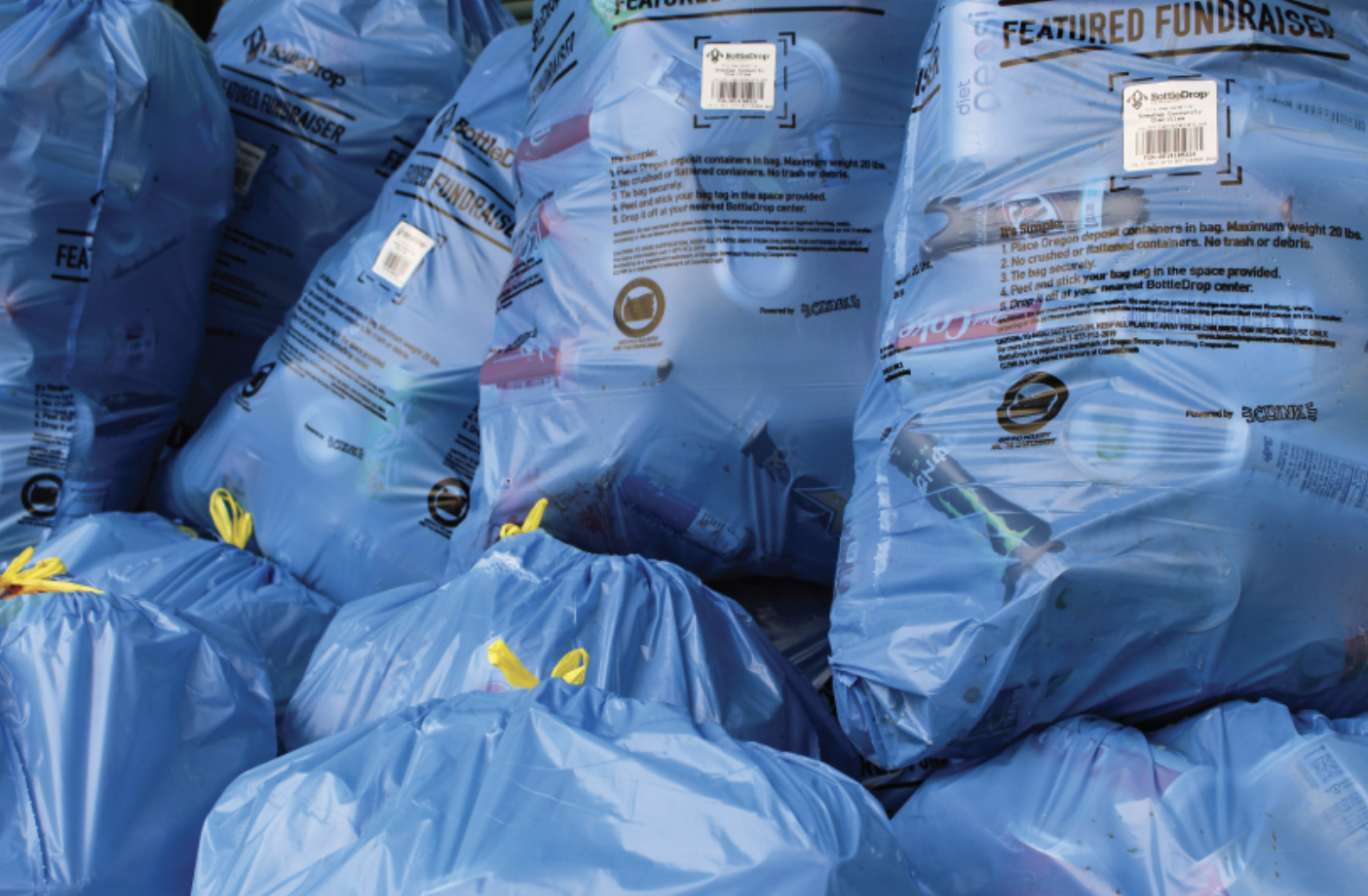
The Mid-Valley SPIN
Newsletter of the Mid-Valley Bicycle Club
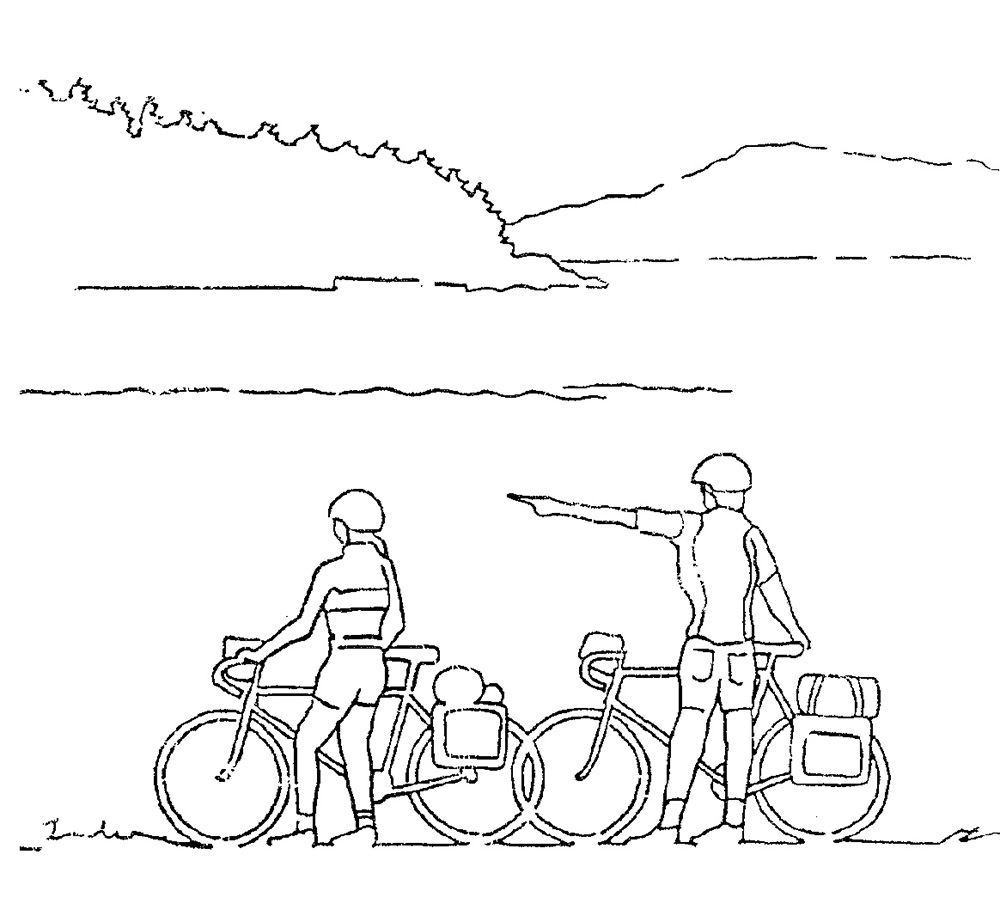 November/december 2022
November/december 2022
Table of Contents
From the President ...
by Paul Lieberman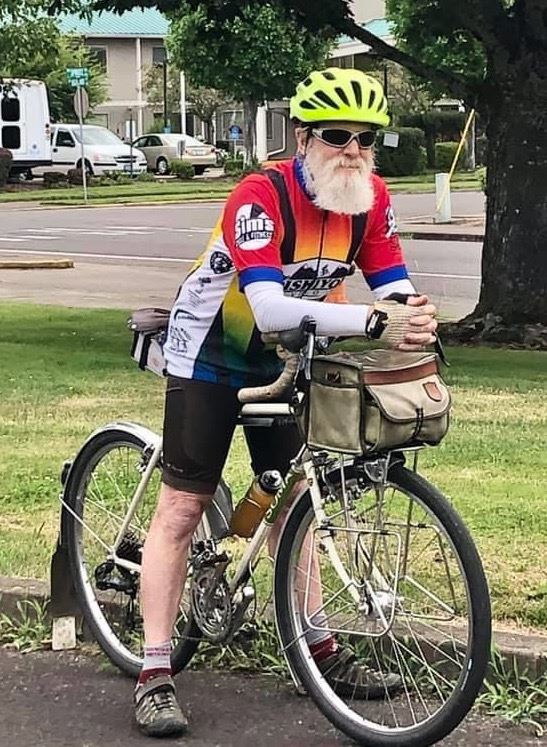
Winter is a great time for reflection. I'm writing this a couple of days after our annual Members Meeting/Banquet where we presented Richard and Lindy Burgess with a lifetime contribution award for their many years of service to the club. I've always placed a lot of importance on the people that came before us and their motivations for doing what they did. I followed this philosophy in my career as well. It was always easy to criticize past decisions with a "what were these people thinking" attitude, but I always said "you know, these are smart people. They must have had a good reason for their decisions, we just need to dig a little deeper to understand what that was."
So I've been digging through the archives to try and learn more about the early days of the bike club. Then I found this Newsletter from 2007 with an article on the club history that goes back to the beginning. Here I learned about our founders, Bob and Marjorie Fry and Dave and Charlene MacManiman. It turns out Dave and Charlene started most of the things we think of as core to MVBC today, including Covered Bridge and Loop Tour. The article itself was written by then president Jim Gau, another member I don't know much about.
Our goal in recognizing Richard and Lindy is to make this an annual award we present at the November Banquet. We'll take nominations throughout the year, so if you have any ideas for long time club members that have made lasting contributions please let me or another board member know so we can add them to the list. Some of these folks are getting pretty old. Some are already gone. Let's let them know how much we appreciate their contributions while we still can.
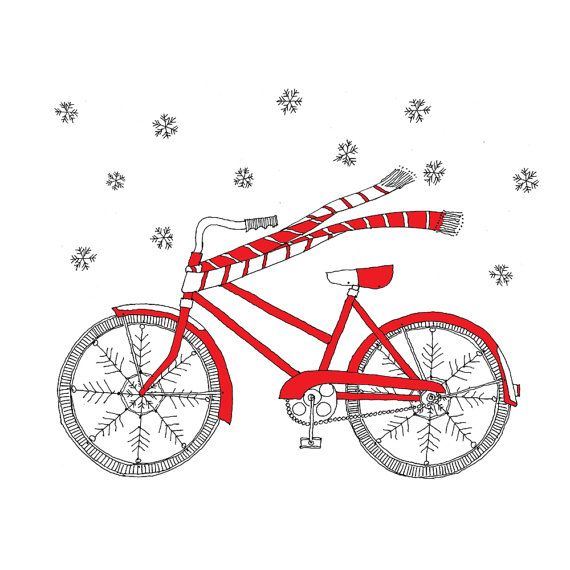
We are very fortunate to have a robust, engaged and growing membership. Share the experience!
Invite friends, family and coworkers to join MVBC to experience the fun, get fit and enjoy the riding camaraderie
Be sure to tell them about our bike packing tours, the variety of our weekly road and gravel rides, our annual cycling events as well as receiving member discount benefits on gear and apparel.
Plus, as members, they can assist with school bicycle educational programs as well as
have a voice through our advocacy efforts with city and county planning officials.
Signing up is easy!
join.mvbc.com
Individual memberships $25, Family memberships $35, Student memberships $10
Fun, Fitness, Camaraderie, Education, Advocacy
by Rob Upson
On a recent sunny fall day I rode my bike to a local store to pickup some food for dinner. The cashier asked if I had any plans for the afternoon. Yes, I said, I was going biking. Where was I going to ride, the cashier asked. I didn't think hard about the answer: "to the grocery store".
Many MVBC members are comfortable riding a bike for errands. Corvallis and Albany are well-suited for this. They are small, flat cities with lots of bike lanes. It's sometimes hard to remember that there are a lot of people hesitant to ride on these streets. They could be new cyclists, and even children. They may not see the roadways the same way as experienced MVBC members.
The City of Corvallis has planned a Low Stress Bike Network to accommodate cyclists of all abilities. The 11st Street Neighborhood Bikeway is one segment of that network. In the coming years we will see more Neighborhood Bikeways on Tyler, NW 27th, NE Lancaster, and SE Thompson. Eventually the network is planned to connect every corner of the city, giving all residents a safer route to travel about town by bike.
The difficulty with building a bike network occurs at the intersections with major roads. For example, northeast Corvallis is cutoff from the rest of the city by highway 99W and Circle Blvd. Both roads are over 4 lanes wide, and very stressful to cross, even for MVBC members. What other intersections create stress for you, your family, or people you know? Do you avoid those intersections when you ride?
In 2023 the city plans to reconstruct and repave the section of Circle between 99W and highway 20 at a cost of over $3.8 million. The Department of Public Works completed data collection for the project and is now in the design phase. MVBC will be advocating for improvements to Circle Blvd. which make it safer, and less stressful for bikers of all abilities for recreation or to run errands.
MVBC plans to launch a new Advocacy webpage to keep members updated on transportation projects and bike safety matters. We will let you know when the page is ready. In the meantime, if you have any questions about bike advocacy feel free to email advocacy@mvbc.com
MVBC's Ride Committee updates ride policy
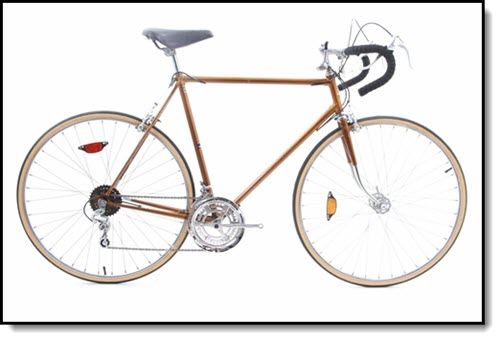
Your ride committee has been hard at work creating an updated ride policy. It includes more comprehensive safety guidelines, a clear statement on allowed e-bikes and a new code of ethics.
It will be added to the website and included in ride leader training materials.
Please take a few minutes to familiarize yourself with the new MVBC ride policy.
Loop Tour heads to the Olympics ... it's the Penincycle
In the long-time tradition of dramatic fashion, Ann Asbell, who has been the chair of the Loop Tour committee since 2015, announced at the annual meeting that Loop Tour 2023 will be going to the Olympic Peninsula in Washington! Also, according to MVBC tradition, the ride has been given a creative nick name: Get ready to ride the Penincycle!
The route will highlight the beauty of the Olympic National Forest and take advantage of some of the Olympic Discovery Trail, the 135-mile trail is composed of road and multi-use pathway. Currently, more than half of the ODT route is on non-motorized paths. For more, visit Olympic Discovery Trail.
The 2023 tour will be updated from tours MVBC has done in the Olympics in the past. (Most recently the Grand Olympic Tour in 2015). Alex Vincent, our incoming Loop Tour chairperson, outlines some key differences: New overnight sites have been added and there are also longer stretches on the ODT, as the trail is longer now than it was in 2015. Day 1 will follow mostly back roads to Shelton, WA. Day 3 has a new destinations: Fort Townsend State Park: only a 6-mile ride away from Port Townsend. (A shorter day on day 3 will also allow time for exploration!) On Day 6, after a layover day in Port Angeles, the route will follow the ODT around the north side of Lake Crescent and into Forks. The Loop Tour Committee is also exploring optional gravel routes.
As always, the loop tour committee strongly encourages carpooling to the start of the tour. For those of you wanting to further minimize your carbon footprint, the committee is creating bike routes to and from the Olympia-Lacey Amtrak station in Lacey, Washington.
If you missed the presentation and would like to learn more, you can view it online. Also keep an eye on the website looptour.org for the latest updates.
Here is a preview of the route.

Bottle Drop fundraiser program success continues to grow |
About 50 people gathered for the return to the in-person annual meeting and banquet. Long-time club members Lindy and Richard Burgess were honored for their lifetime contributions to the MVBC club. Outgoing board secretary Kathy Hall was honored. Throughout her time with the club, she has spent over 20 years as club secretary. Eileen Tokuda, membership director/ride committee chair, was also honored for her dual roles and spearheading a several very successful marketing programs. (Eileen also coordinated the site of the banquet.)
The board gathered to transform Imagine Coffee into a banquet hall. Green Girl provided the dish ware and the meal was catered by Corks and Forks. A huge thank you to Lindsay Parker for organizing the service through Green Girl and washing all the dishes after the event! The extra efforts by Lindsay ensured close to zero waste was produced at the event: what a great accomplishment!
Remembering MVBC History
contributed by Susan Christie
We used to give out a variety of awards at the annual dinner each November—some of them silly, and some of them serious. There were awards for MVBC members who had ridden lots of club miles that year. There was a “Route Scout” award for riders who missed a turn and went astray on Loop Tour. Matt and I and several other people won that one a time or two! But probably the most memorable was the Doo Dah award. Don and Betsy Reid are preparing to move, and in the process of sorting and packing recently, Betsy discovered the Doo Dah award, together with the plaque telling the story of Doo Dah, as written by Bill Daley. Following is the story on the plaque, just as Bill wrote it years ago.
The Story of the MVBC “Doo Dah” Award
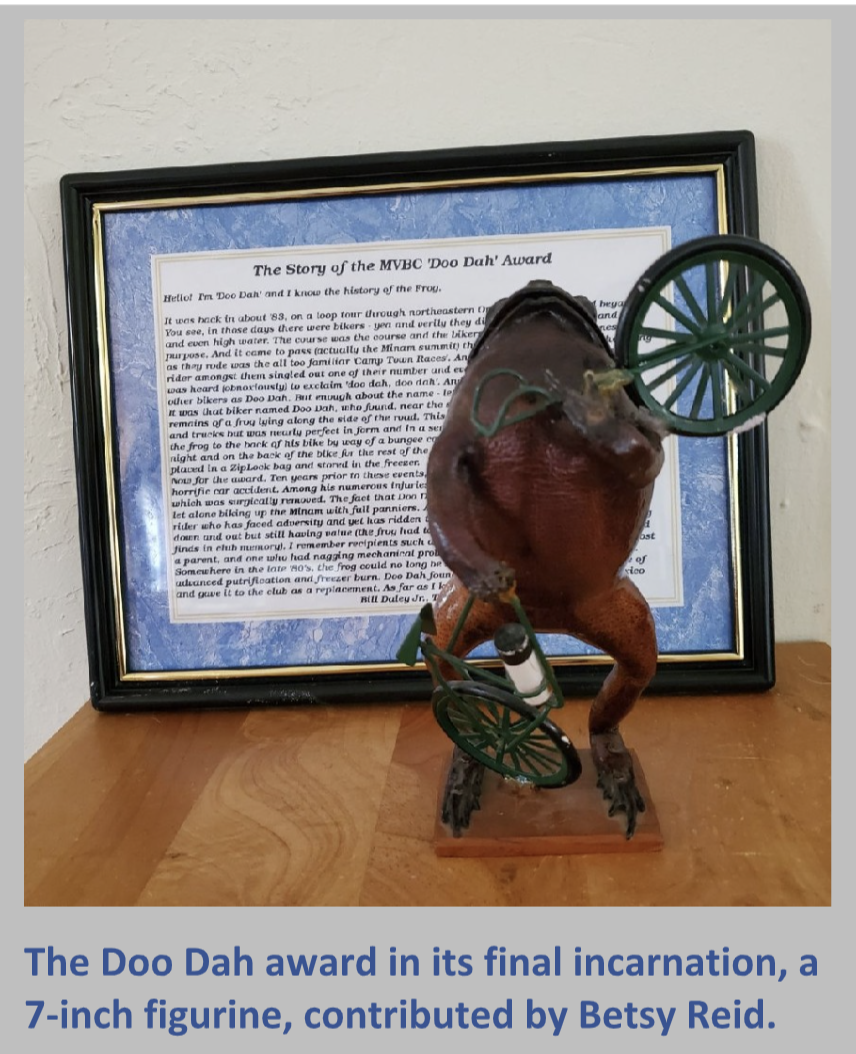 Hello! I’m “Doo Dah” and I know the history of the Frog.
Hello! I’m “Doo Dah” and I know the history of the Frog.
It was back in about ’83, on a loop tour through northeastern Oregon that the legend began. You see, in those days there were bikers—yea and verily they did ride, through sleet, and rain, and even high water. The course was the course and the bikers did ride it with singleness of purpose. And it came to pass (actually the Minam summit) that one of the road songs they sang as they rode was the all too familiar “Camp Town Races.” And, silly as it may seem, a small rider amongst them singled out one of their number and every time they were in close proximity was heard (obnoxiously) to exclaim “doo dah, doo dah.” And so the rider became known by the other bikers as Doo Dah.
But enough about the name. Let’s get to the frog and the award. It was that biker named Doo Dah who found, near the summit of Minam Pass, the petrified remains of a frog lying along the side of the road. This frog had been flattened by passing cars and trucks but was nearly perfect in form and in a semi-mummified state. Doo Dah mounted the frog to the back of his bike by way of a bungee cord and proudly displayed it in camp that night and on the back of his bike for the rest of the tour. He took the frog home where it was placed in a ZipLock bag and stored in the freezer.
Now for the award. Ten years prior to these events, the biker known as Doo Dah had been in a horrific car accident. Among his numerous injuries was a broken femur, ankle, and knee cap which was surgically removed. The fact that Doo Dah could even ride a bicycle was a miracle, let alone biking up the Minam with full panniers. And so an award was created to honor the rider who has faced adversity and yet has ridden the course. The frog was the symbol of being down and out but still having value (the frog had taken on some notice as one of the best road finds in club memory). I remember recipients such as a rider who had cancer, one who had lost a parent, and one who had nagging mechanical problems but who always finished the ride. Somewhere in the late ‘80s, the frog could no longer be stored in recipients’ freezers because of advanced putrefaction and freezer burn. Doo Dah found a stuffed frog in a market in Mexico and gave it to the club as a replacement. As far as I know that is the frog you now have.
Bill Daley Jr., “Doo Dah”
Upcoming Events ...
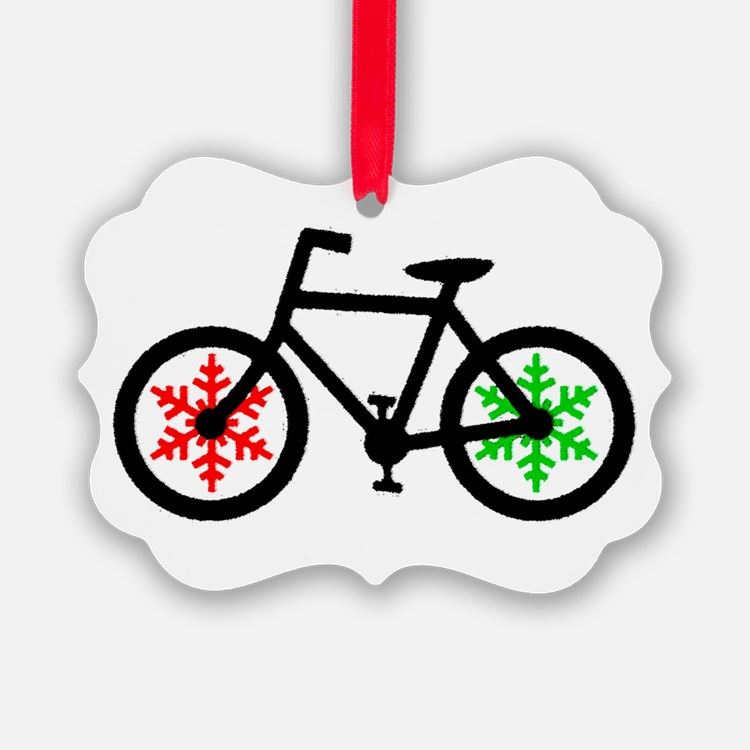
MVBC Holiday Party, December 17
Join in some holiday fun with your fellow riders! We'll gather from 1-3 p.m. at Common Fields Pride Pavilion in Corvallis. Members will receive $5 towards their purchases. There will also be a few door prizes so come join the fun. Holiday attire is welcome!
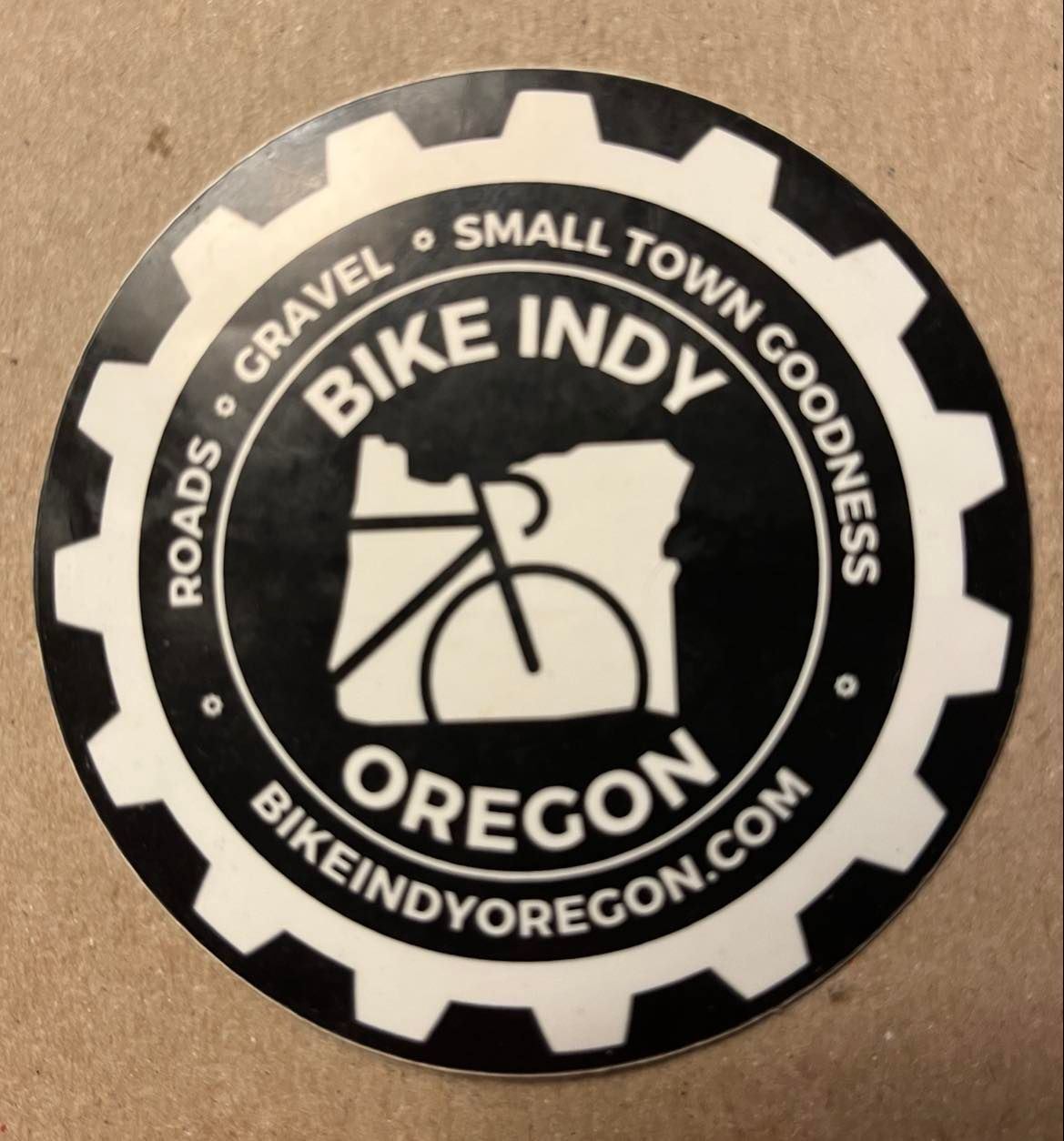
Bike Indy, Hot Chocolate Ride, January 14
Don't let the winter weather stop you! Bundle up and join Bike Indy for a ride! This free winter ride starts and ends in Independence where a food truck is waiting with tamales and a traditional Mexican hot chocolate drink, Champurrado, to purchase.
Bike Indy will return with "Drop the Hammer" quarterly events again for 2023: the winter edition is scheduled for January 2-29. Bike Indy events are free to attend. The ride has a Strava segment where riders can choose to "drop the hammer" to compete for prizes for the fastest time on the segment. There are road and multi-surface routes and varying lengths, including a family friendly ~3 mile route.
Bike Indy gear (socks, coasters, etc) will soon be available at several Bike Indy storefronts in Independence: Indy Commons, The Heritage Museum and the chamber. Bike Indy will host additional events in 2023, including multi-day rides and a camp out. Don't miss the fun! Follow Bike Indy on Facebook or sign up for email notifications at BikeIndy.
Pedal Power: Bicycles in the Willamette Valley
A new exhibit visits Heritage Museum in Independence
The Independence Heritage Museum has curated a new, temporary exhibit: Pedal Power: Bicycles in the Willamette Valley, which will be open to the public for the month of December at the Heritage Museum in Independence.
The exhibit follows three tracks: 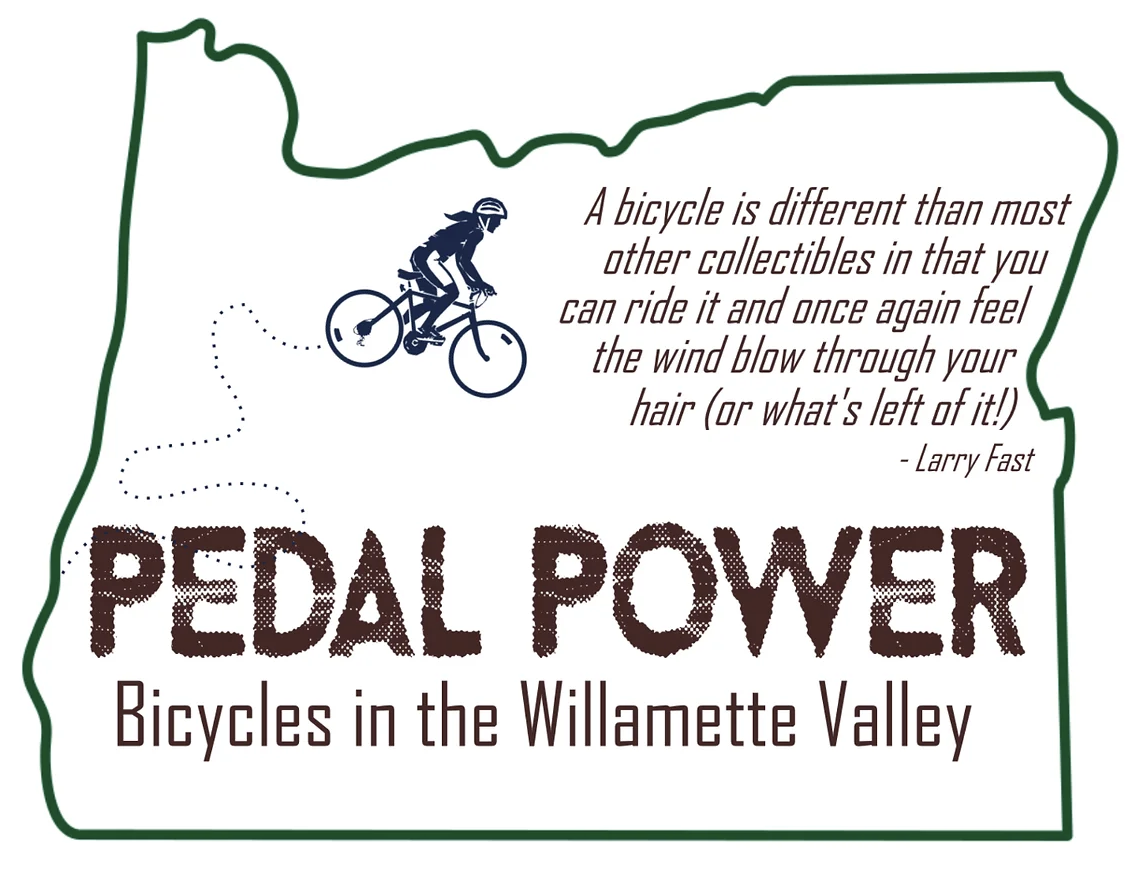
- The story of local bicycle collector, Larry Fast and a small glimpse into his collection
- The history of Oregon’s Scenic Bikeways (the only state in the country to have designated scenic bike routes)
- Bike safety and information and helmet give-away
Visiting the exhibit will evoke nostalgia for bygone bikes, and feature Larry Fast, a passionate, local antique bicycle collector. Five bikes will be on display, along with information about each, and why Larry has made them part of his collection. (Fast was on-hand on December 3 to talk about the exhibit and answer questions.)
Pedal Power explores the innovative thinking behind Oregon’s Scenic Bikeway. Modeled after automobile scenic byways, Oregon’s Bikeways are hailed as being the first and only program in the United States with official state-designated bike routes, as well as printable maps, GPS cue sheets, and on-road signage.
Finally, in partnership with the Oregon Department of Transportation, Cycle Oregon, and Mid-Valley Bike Club, the exhibit will provide free take-home information about bike safety and rules for all ages.
The Heritage Museum Gift Shop will feature new items related to the exhibit, and museum members receive 10% discount on all store purchases. Bicycles have become synonymous with Oregon – visit the Heritage Museum in December to learn more about one of Oregon’s favorite pastimes.
Check out our website: www.orheritage.org or our Facebook page: www.facebook.com/IndependenceHeritageMuseum for more information.
Admission to the Heritage Museum is always free, and donations are gratefully accepted. The museum is open Tuesday – Thursday 10AM – 6PM, Friday & Saturday 10AM – 4PM, and closed Sunday & Monday.
December 3 was a big day at the museum for MVBC's helmet program coordinator Nancy Meitle. That day, 38 kids who came to the exhibit were properly fitted for helmets. As always, once the perfect helmet has been selected, the child may take the helmet home for free (donations are encouraged.)

Biking--and Beyond--on the Outer Banks
by Patti Watkins
When I first mentioned this trip to my MVBC friends, I found that many had never heard of the Outer Banks, a beloved vacation spot of mine since my family first visited there in 1965. The Outer Banks are a string of barrier islands off the coast of North Carolina, although the northern-most section is actually attached to the mainland as the inlets of Bodie Island and Currituck Banks no longer exist. The banks are lined by the Atlantic Ocean to the east and a series of sounds to the west. Highway 12, more affectionately known as “the beach road,” now extends from the town of Corolla in the north, south and across the Oregon Inlet by bridge onto Hatteras Island, then, after a ferry crossing from the southern tip of Hatteras Island, onto Ocracoke Island and another 15 miles south from the ferry landing to Ocracoke Village. My intent on this trip was to bike every mile of Highway 12. In preparing for this journey—and to learn more of the history of the highway--I read the book, NC 12-Gateway to the Outer Banks. Book
When I told a fellow MVBCer that I planned to spend three weeks traversing the approximately 120-mile distance between the northern and southern points and, of course, the 120 miles back again, she stared at me incredulously wondering why in the world I would take such a long time biking such a relatively short distance—a distance any Loop Tourer could easily bike in 4-5 days, especially given that the Outer Banks are fairly flat. For me, this trip was more than just about the biking. I wanted to stop and spend some days cavorting in the surf and strolling the beach searching for shells and sand crabs as I had in my youth, revisiting spots that were near and dear to me throughout my childhood. I also wanted to explore the area in ways I seldom had before. While I loved spending entire days on the Atlantic beach, our family vacations largely neglected the vast inland waterways and surrounding maritime forest. Thus, I built in time to hike and kayak these previously unexplored aspects of the region.
I arrived on the Outer Banks on September 10th, past peak vacation season when the crowds have dissipated, the traffic is lighter, and the motel prices are lower. The weather is typically still warm, but not as hot and humid as during the summer, and the ocean temperature usually remains in the upper 70s throughout the month. The only caveat is that September marks the height of the hurricane season! Neither Hurricane Fiona or Ian made landfall on the Outer Banks, but my time there was bracketed by these two storms which kept me out of the ocean due to rough surf and rip tides on some days at the beginning and end of my trip.
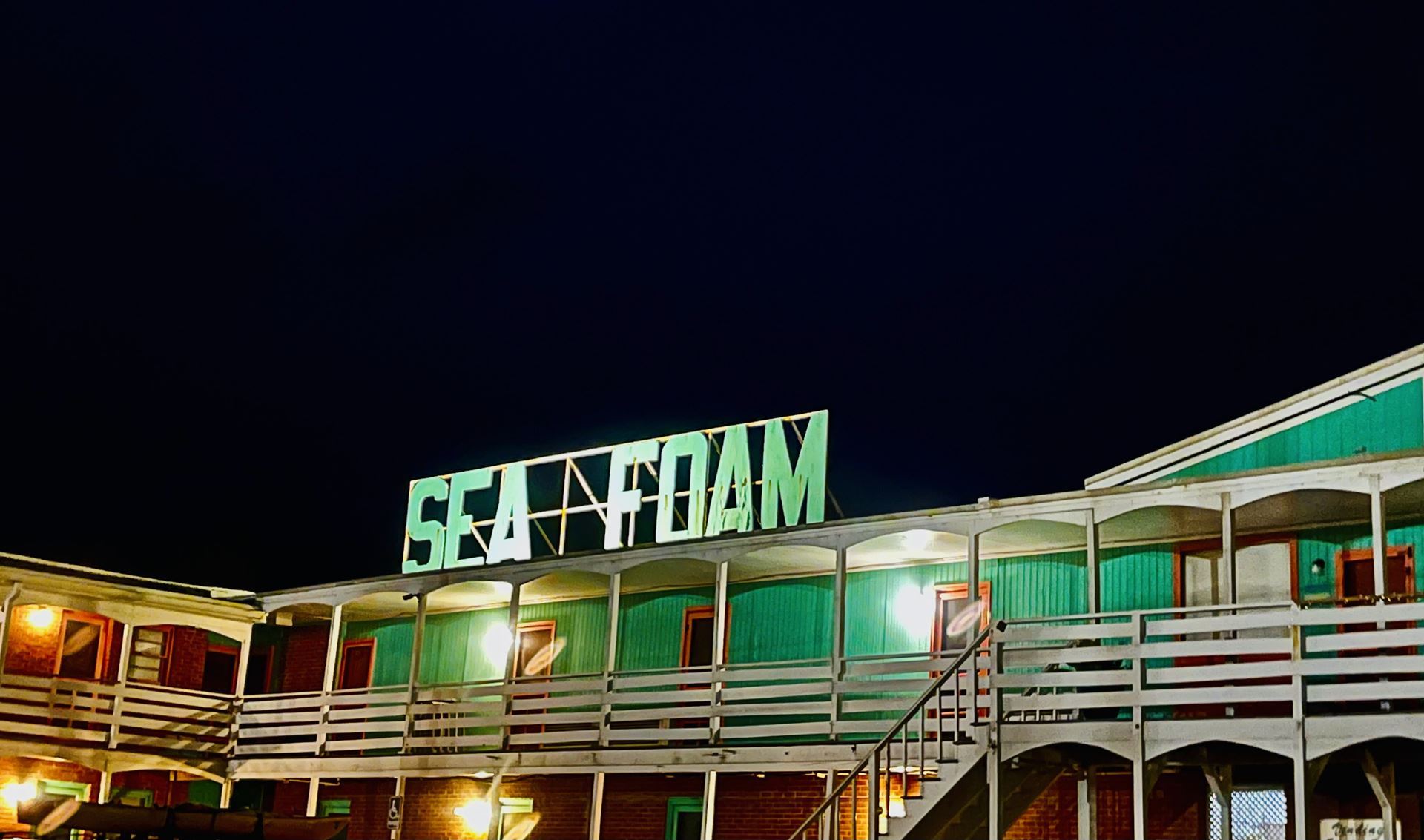
I had never solo bike toured before nor had I carried my own gear. Although the banks are dotted with campgrounds, I opted for motels starting with the Sea Foam motel in Nags Head where my family first stayed on our vacations there. The Sea Foam, now on the National Register of Historic Places, is one of the few remaining motor court motels of the 1950s-60s era as most have been replaced by luxury condominiums. With its swimming pool, shuffle board court, and iconic sea green signage, it remains much as I remember from my childhood--although the soda machine no longer dispenses Nehi grape soda. Happily, I discovered that the long-standing, family-run Cahoons market next door still sells it!
I made the Sea Foam my base of operations for a few days before heading north on my bike, dubbed “Rootin’ Tootin’ Raspberry,” given that its color according to Bike Friday is “candy raspberry.” Throughout my trip, men inquired as to the mechanics of the bike while women complimented the color and remarked how well my outfits, specifically Nuu-Muus, matched! I was unable to adequately answer the mechanical questions, but I did share the Nuu-Muu website at least a half dozen times! The Sea Foam staff were delighted to hear that I’d spent childhood vacations there, and, as it turned out, the managers, John and Terry, were cyclists themselves. Although they hail from Virginia, they recognized my Bike Friday from a trip through Oregon where they visited the factory! Such was our bonding over bikes that they allowed me to leave my car parked at the motel rather than having to pay a storage facility to hold it while I was biking. After three days—and a 20-mile trial run to Kitty Hawk and back—I was ready to hit the road in earnest.
I decided to head north initially as this is the far more populated section of the Outer Banks, figuring if I had any difficulties, help would be more readily available. I biked the entire way on Highway 12 or the multi-use path that runs adjacent to it in parts, about 40 miles, to Corolla. Highway 12 ends here, though the beach, known as Carova Beach, stretches 20 miles to the Virginia border. I stayed at the Inn at Corolla on Currituck Sound so that I might explore this area which was truly just a roadless outpost until the late 1980s. I biked the multi-use path and backroads to the lighthouse and the old village, dating from the late 1800s, as well as to the jumping off points for a sunset kayak outing on the sound and a wild horse tour via a 4-wheel drive vehicle beyond road’s end. “What wild horses?!,” you may ask. The horses that roam this area are descendants of Spanish mustangs abandoned from ships that sailed these shores in the 1500s. I was especially excited to see the horses as any girl who’d ever read Misty of Chincoteauge would be! During my childhood trips to the banks, they were merely the stuff of legends, but now I finally got to see them in the flesh, grazing among the dunes.
On my return trip from Corolla, I rode a slightly longer route, veering west off of Highway 12 to the back roads just south of Duck, a more developed tourist town featuring a few art galleries and a bevy of eateries. I actually opted for a roadside stand where I munched on fresh fruit and locally made smoked tuna salad, washed down with a grape Nehi! I was quite hungry and wanted something quick as I had taken a kayak tour of the Pine Island Audubon Sanctuary enroute, a peaceful morning paddle through the Currituck marshlands. This day’s bike route ran, in part, along Kitty Hawk Bay, eventually emerging in Kill Devil Hills near the Wright Brothers National Memorial which I’d visited back in 1965. I had to stop here to pose my Bike Friday next to the replica of the Wright Brothers’ plane before pedaling on to my car in Nags Head. I had to wonder what Orville and Wilbur would have thought of Rootin’ Tootin’ Raspberry as the brothers had actually built and sold bicycles back in Ohio, using the profits to fund their subsequent experiments in flight on the Outer Banks!
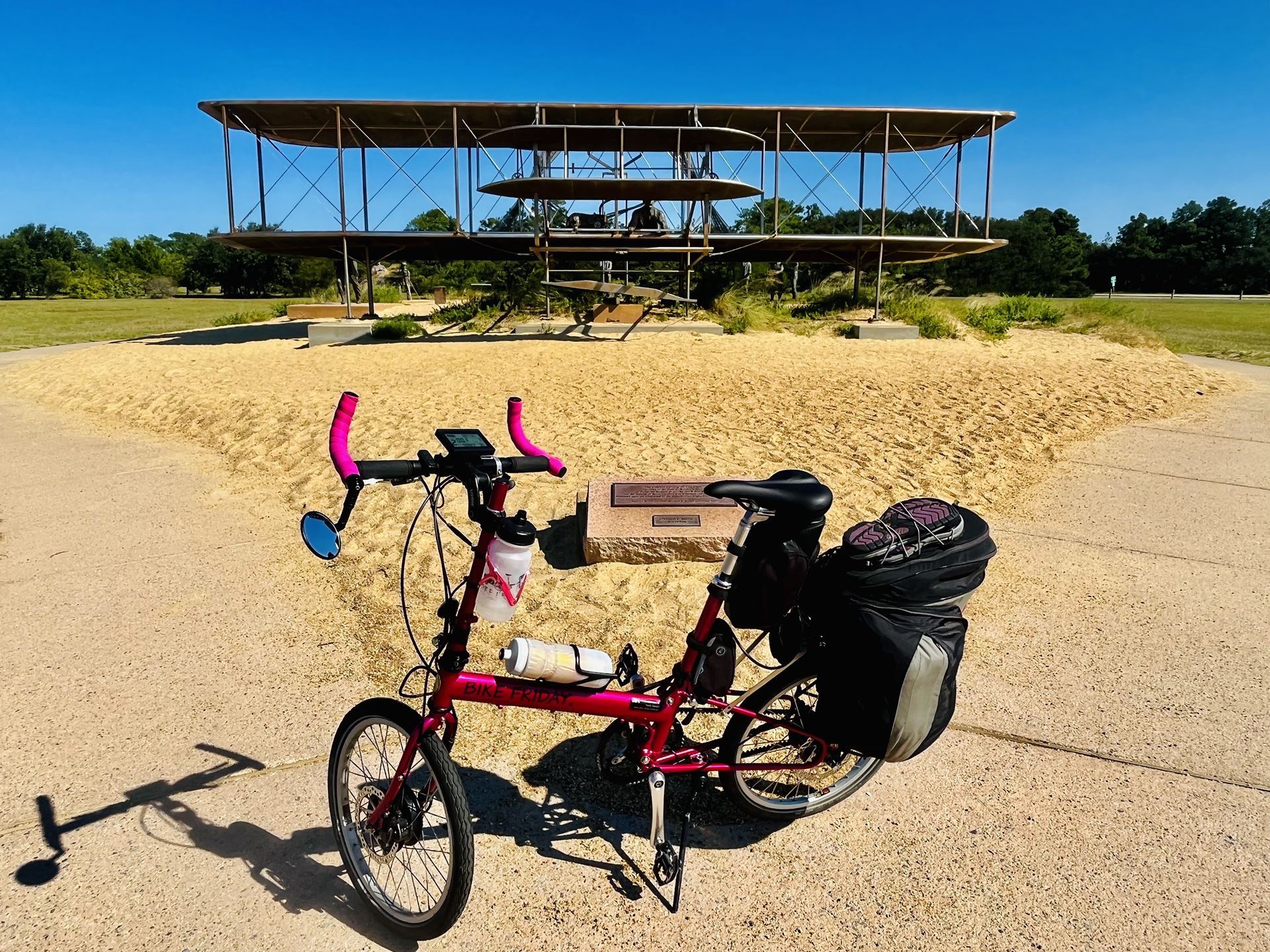
Next, I spent four nights at the Tranquility House Inn in the town of Manteo on Roanoke Island. Although the island is a short hop across the causeway, I retrieved my car for my stay here, mostly because I’d booked a kayak outing from the Alligator River National Wildlife Refuge for which the starting point was 20 miles further west along busy Highway 64 as well as unpaved roads. This may have been my favorite of my five Outer Banks kayak tours. The paddle trail traversed swampy wetlands where we spotted a number of turtles basking on logs as well as a few alligators on the fringes of the marsh grass! While on Roanoke Island, I also viewed aquatic wildlife at the North Carolina Aquarium, sampled regional microbrews at the Lost Colony Tavern, wandered through a Pride Festival at the local park, sampled craft cocktails at 1587 Restaurant and Lounge, and lunched on the best scallops ever--freshly harvested from Roanoke Sound--at a seafood shack in Wanchese.
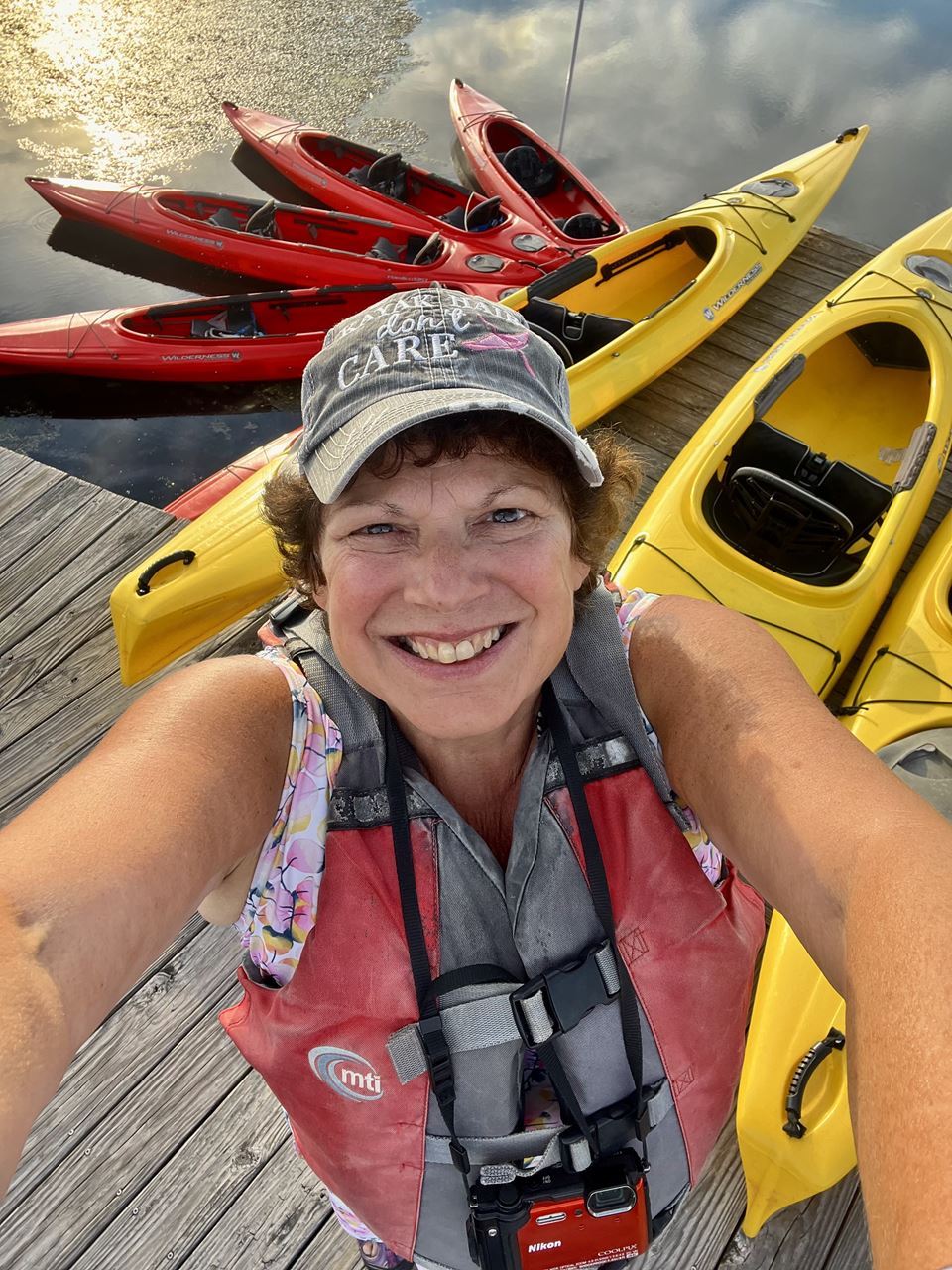
At this point, I was ready to begin making my way south onto the far less populated Cape Hatteras National Seashore, which begins just a mile or so south of the Sea Foam motel in Nags Head and extends 70 miles along Bodie, Hatteras, and Ocracoke Islands, crossing two inlets along the way. Only a handful of villages exist along this stretch of Highway 12, including Rodanthe where I had reserved a room for two nights at the Sea Sound motel. This made for a 25-mile riding day during which I made a quick stop at the Bodie Island Lighthouse. I had driven to the lighthouse during my first few days on the banks and walked the trail around the grounds. Continuing south, I next stopped at the Pea Island Wildlife Sanctuary where the shaded porch of the visitor’s center made for a good Gatorade stop on this humid day. I had driven here earlier in the trip and walked the trails where I spotted various marsh birds and freshwater turtles. I’d also taken a sunset kayak tour of Pea Island before the biking portion of my trip commenced.
From the porch at the visitor’s center, I messaged some of my MVBC peeps expressing trepidation about the next portion of the day’s ride when I was due to cross the new 3-mile long Basnight Bridge spanning the Oregon Inlet. My family and I had spent many hours fishing off the old Bonner Bridge, hauling in croakers and some goodly flounders. Thus, I recalled how perilously narrow the old bridge had been. Fortunately, the new bridge was built to accommodate cyclists! (New Bridge) At six feet, it had the widest shoulder of any section of Highway 12, matched only by the next bridge that I encountered, one that spanned Pamlico Sound for 2.5 miles leading into Rodanthe. I thought that my memory had betrayed me as I’d not recalled a second bridge on Hatteras Island, but learned that this one was newly constructed, opening only two months before my arrival. The barrier islands that form the Outer Banks are very narrow, rarely with more than one mile separating the sounds from the sea and, at one point, only 150 yards in width. As such, many portions of Highway 12 are prone to flooding, not from precipitation per se, but simply from storm surge when high winds coupled with high tides cause the water to permeate the dunes and spill onto the road. Such was often the case near Rodanthe where storm breaches regularly resulted in road closures. The new bridge was built to resolve this problem.
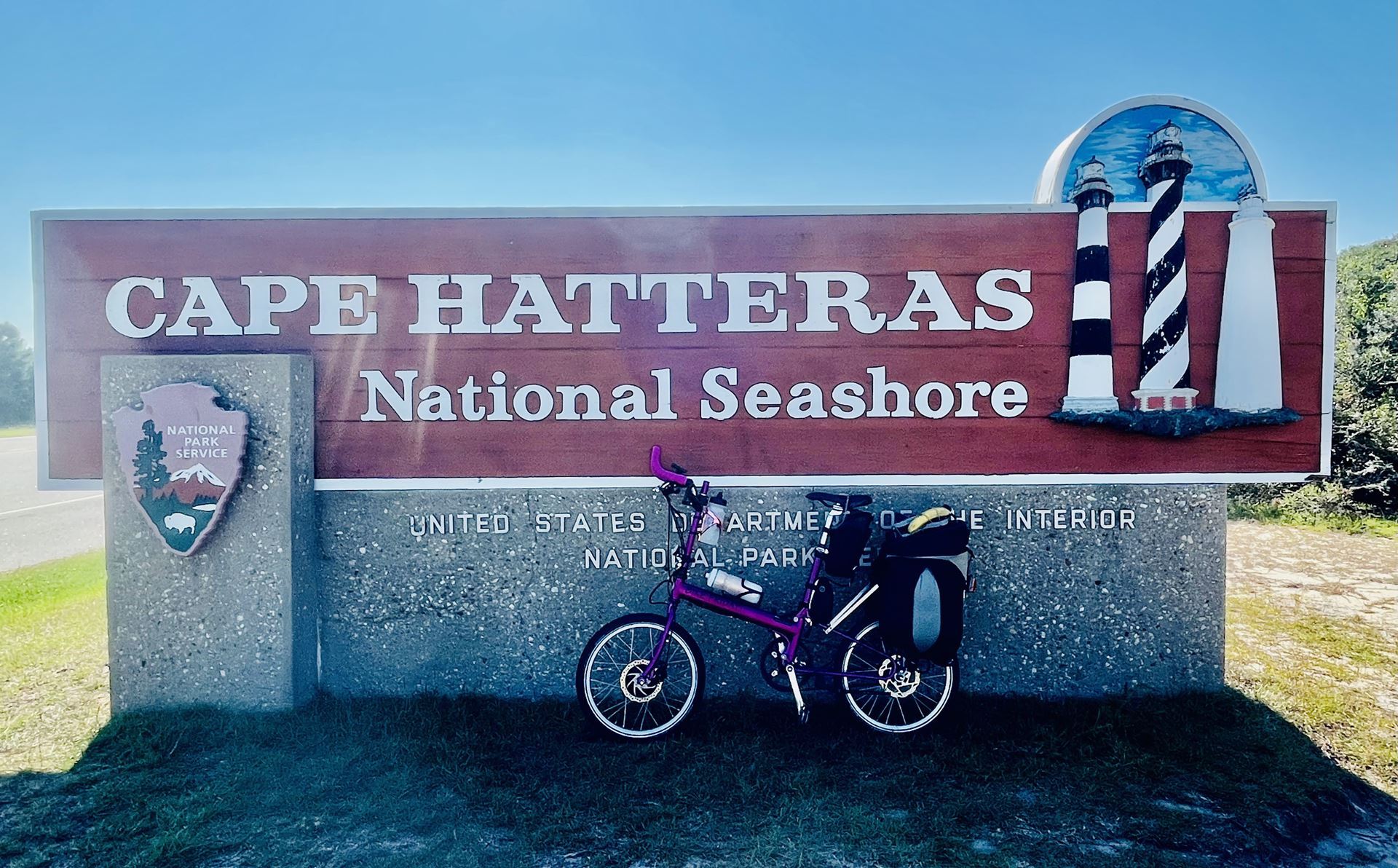
I stayed at the aptly named Sea Sound Motel in Rodanthe, another motor court style lodging of the same era as the Sea Foam. I had an idyllic day wandering the beach at sunrise and playing in the waves all afternoon. After two nights here, I biked another 25 miles south to Buxton where I visited the Cape Hatteras Lighthouse, the tallest brick lighthouse in the US. Had it not been closed for remodeling, I would have climbed the stairs to the top as I did when I was a kid and it was located in its original spot nearer the beach. This was my first time visiting it in its new location, though I witnessed part of the move during a trip in 1999. After two nights at the Cape Pines motel in Buxton, I rode about another 25 miles to Hatteras where the ferry transported me and my bike across Pamlico Sound to the northern tip of Ocracoke Island.
The cars that had been on the ferry quickly passed by, leaving me and Rootin’ Tootin’ Raspberry alone on this portion of Highway 12. It was an eerie feeling biking between the dunes with no other person or vehicle in sight. I imagined I was traversing through a post-apocalyptic landscape--until I got to the pony pens halfway down the island. Unlike the horses that roam free north of Corolla, the equine descendants of Spanish mustangs on Ocracoke have been penned since 1959 for their protection and cared for by the National Park Service.
I spent three nights in Ocracoke Village, staying at the Harborside Motel. I biked along the back roads, at times needing to dodge the ubiquitous golf carts driven by tourists in lieu of cars. In my mind, I likened them to an invasive species, but I suppose they are a lesser evil than having automobile traffic in this tiny town. I visited the last of the four lighthouses on my tour, this one positioned on the edge of Silver Lake which is actually the town’s harbor—and the former haunt of Blackbeard the Pirate. I rented a kayak and paddled through Silver Lake, and out to Teach’s Hole which is where Blackbeard met his demise at the hands of the British Navy. Passing Springer’s Point, I navigated into Old Slough where I found myself in solitude with only birdsong as a backdrop.
During my stay on Ocracoke, I took a tour of the abandoned settlement on nearby Portsmouth Island, foolishly eschewing the mosquito suit that our boat captain offered! Nevertheless, I enjoyed rambling around the ghost village and exploring structures such as the church and coast guard station that had been central to this once-thriving community. Our captain then dropped us off on a beach further down the island that was mercifully free of mosquitos where the six of us sunned ourselves, waded in the warm water, and searched for sea shells along the unspoiled shore. On the way back, we stopped alongside a small island that served as a pelican rookery. As we made our way back to the harbor, the boat captain regaled us with tales of American ships sunken by German U-boats off these shores during World War II, stories passed down from his family who has lived on the island for many generations. The former keepers’ quarters at the Cape Hatteras Lighthouse, now the Museum of the Sea, highlights the history of the Outer Banks during the Civil War as well as both World Wars.
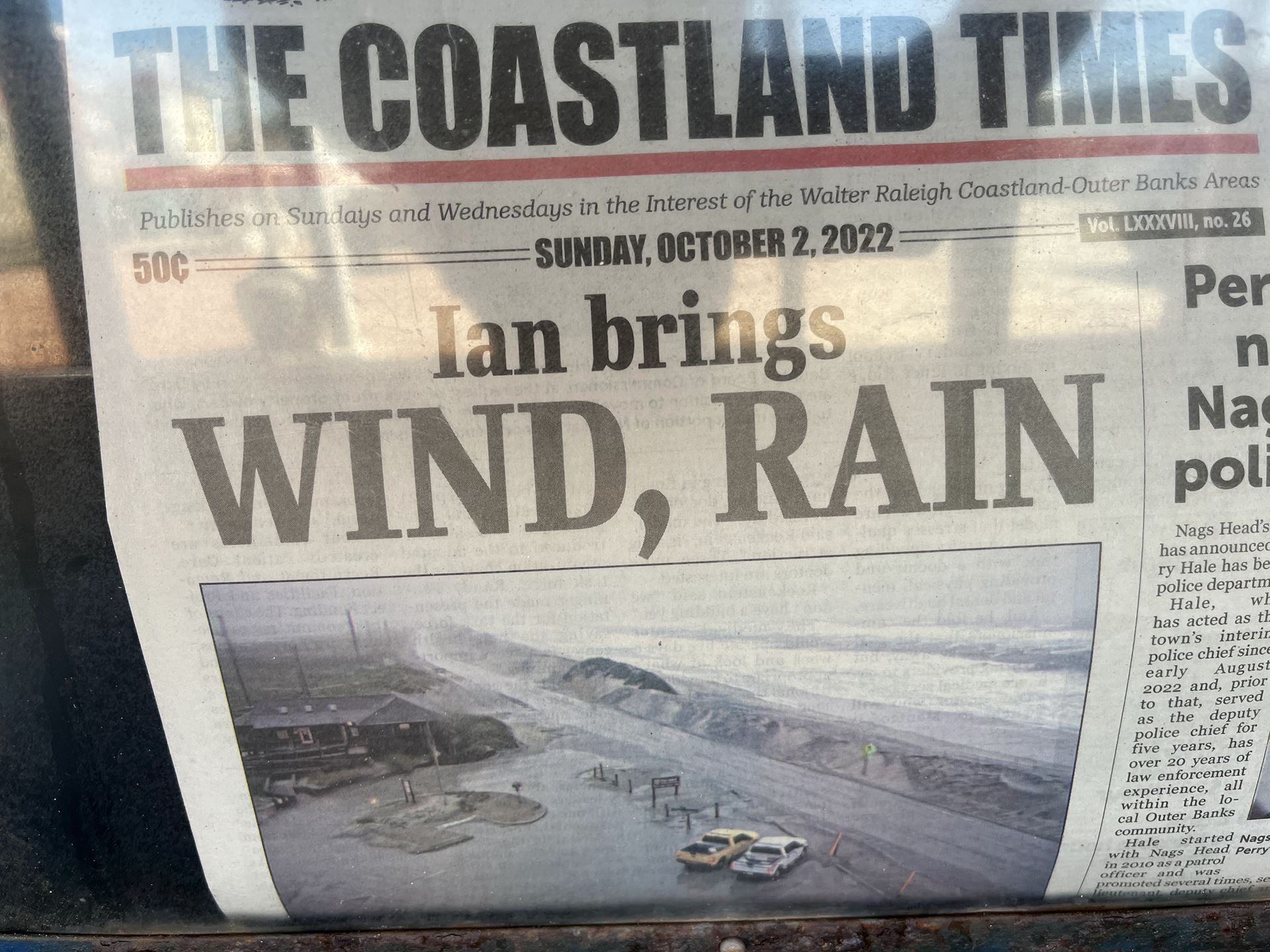
Although I’d broken up the ride from Nags Head to Ocracoke into three segments with multi-night stays, my schedule was such that I needed to return to Nags Head in two consecutive biking days. The impending arrival of Hurricane Ian added to my sense of urgency to return to the safety of the Sea Foam. Fortuitously, I was able take the pedestrian-only ferry back to Hatteras which departs from Ocracoke Village rather than the north end of the island. This saved me from biking an additional 15 miles against a strong headwind. Now at the end of tourist season, I happened to be the one and only passenger on a boat that can accommodate over 100 people. I felt as though I were on a private cruise with the crew outnumbering me three to one! When I landed in Hatteras, I had only 35 miles left to ride to the Sea Sound motel in Rodanthe, once again my destination for the night. Technically, the motel was closed for the night, but the kindly proprietors, Fred and Sharon who I’d met on my previous visit, prepared a room before they went away and left a key in the mailbox for me!
The next day, I had 25 miles and 2 bridges to traverse between the Sea Sound and the Sea Foam. Although the sun was still shining, the headwind from the hurricane’s proximity had picked up substantially over night. I don’t think I’ve ever been happier to have the electric-assist on my bike, nor happier to see the South Nags Head sign when I eventually reached town. The Sea Foam staff gave me a warm welcome upon my return, offering to tote my bags that I’d left in their office to my room and writing “Welcome Home!” on my check-in paperwork. I felt as though I were visiting royalty!
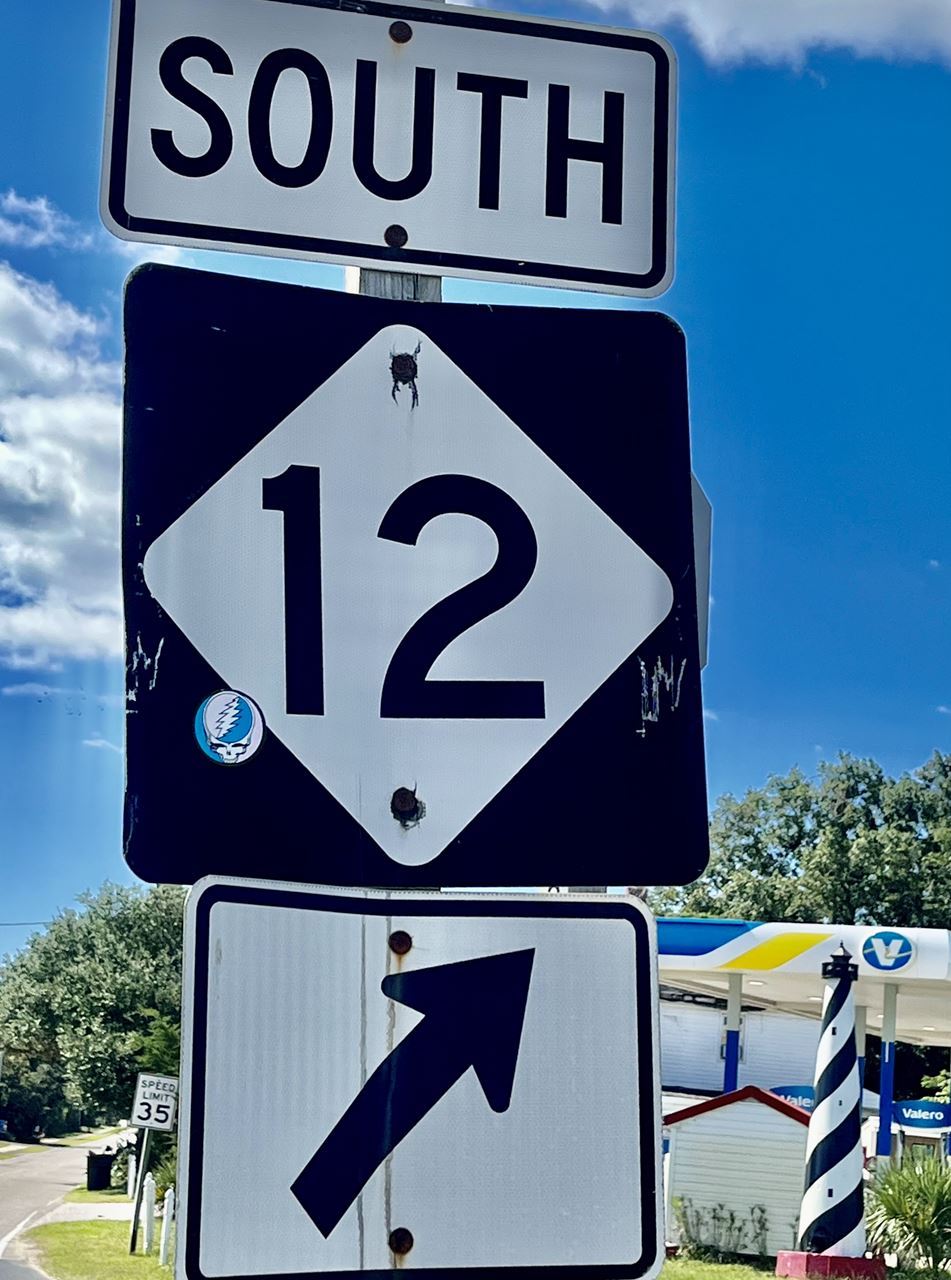
That evening, I sneaked in one more kayak outing before the Outer Banks felt the brunt of Hurricane Ian. On this tour, we paddled through Kitty Hawk Woods Coastal Reserve along a sheltered creek where loblolly pines and oak trees draped in Spanish moss lined the banks. I hunkered down in my room the next couple of days when the wind and rain were in full force. When the wind began to subside, I ventured out to the end of nearby Jennette’s Pier to watch the roiling waters. On my last morning at the Sea Foam, the storm had largely passed and I was able to enjoy a muted sunrise as I took one last walk along the beach. I then packed my bags and Rootin’ Tootin’ Raspberry into the back of my Subaru (or “Uberu” as it is known to some of the MVBCers) and bid adieu to the Sea Foam staff including Itty Bitty, the resident stray cat, before beginning my drive back to Oregon.
Although I totaled only 275 miles, hopefully now one can understand why I spent three weeks biking the Outer Banks! Apart from the sheer joy of cycling, the area offers so much more in way of outdoor recreational activities not to mention its natural beauty, rich history, and delectable seafood. This last website has links to bike route maps that cover the areas that I traveled, with the exception of Ocracoke Island Things to do Outer Banks. Perhaps my story will inspire other MVBCers to ride the beach road themselves and to sample all that the Outer Banks have to offer!
Podcast review: A creative way to get more kids riding bikes to school
Duolingo episode 112: /Climate Heroes - Biking in Spain
review by Tracy Hug
When I feel the need to brush up on my Spanish, I enjoy listening to some of the Duolingo podcasts. Their storytellers use intermediate Spanish and the host adds context in English. In 2022, they are including stories of people who are making a difference in climate change. One that caught my attention was about the bicibús, or bike-bus.
If you know some Spanish, or even if you don't know Spanish but are feeling adventurous, give it a try!Bici Bus
If you prefer to stay closer to home, you can read about a Portland school where 150 kids joined together to share the ride to school. Portland Bike Bus
Upcoming events
- No upcoming events

